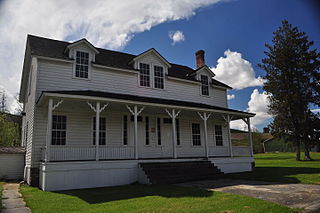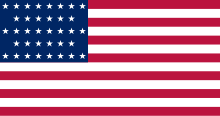The Snake War (1864–1868) was an irregular war fought by the United States of America against the "Snake Indians," the settlers' term for Northern Paiute, Bannock and Western Shoshone bands who lived along the Snake River. Fighting took place in the states of Oregon, Nevada, and California, and in Idaho Territory. Total casualties from both sides of the conflict numbered 1,762 dead, wounded, or captured.

The 4th California Infantry was a volunteer infantry regiment recruited from northern California during the American Civil War. It was organized at Sacramento, Placerville, and Auburn in September and October 1861.
Brackett's Minnesota Cavalry Battalion was a Minnesota USV cavalry battalion that served in the Union Army during the American Civil War.

The history of Idaho in the American Civil War is atypical, as the territory was far from the battlefields.

The 1st Regiment of Washington Territory Volunteer Infantry was a unit of infantry raised by the Washington Territory for service in the Union Army during the American Civil War.
The 9th Kansas Cavalry Regiment was a cavalry regiment that served in the Union Army during the American Civil War.

The 2nd Regiment California Volunteer Cavalry was a cavalry regiment in the Union Army during the American Civil War. It spent its entire term of service in the western United States, with most of its companies dispersed to various posts.

The District of Oregon was a Union Army command department formed during the American Civil War.

The 2nd Regiment California Volunteer Infantry was an infantry regiment in the Union Army during the American Civil War. It spent its entire term of service in the western United States. Organized at San Francisco and Carson City September 2, 1861, to December 30, 1862, and attached to Department of the Pacific. The regiment was first assembled at the Presidio, San Francisco, and after completing its organization, five companies were sent to Oregon and Washington Territory, to relieve the regular troops, and two companies were sent to Santa Barbara. The troops of this regiment sent to Oregon were afterwards returned to California. It was mustered out during the month of October, 1864.
Camp Lapwai was a United States Army encampment in Washington Territory, present-day Idaho. It was established by Company E, 1st Regiment Washington Territory Volunteer Infantry. After being mustered in at Alcatraz at San Francisco, California, they were ordered on October 19, 1862, to Camp Lapwai near the Nez Perce Agency. Joined there at the beginning of November by Company "F", 1st Oregon Volunteer Cavalry Regiment, they built the encampment. Camp Lapwai was renamed Fort Lapwai in 1863; the new Idaho Territory was also established in 1863.

Fort Lapwai (1862–1884), was a federal fort in present-day Lapwai in north central Idaho, United States. On the Nez Perce Indian Reservation in Nez Perce County, it was originally called Camp Lapwai until 1863. East of Lewiston, it was located on the west bank of Lapwai Creek, three miles (5 km) above where it joins the Clearwater River at the state's first settlement, Lapwai Mission Station, built in 1836 by Henry Spalding. It is part of the multi-site Nez Perce National Historical Park. The word "Lapwai" means place of the butterflies, as the area had thousands in early summer in earlier years.

The 6th Regiment California Volunteer Infantry was an infantry regiment in the Union Army during the American Civil War. It spent its entire term of service in the western United States attached to the Department of the Pacific.

1st Battalion California Volunteer Mountaineers was an infantry battalion in the Union Army during the American Civil War. It spent its entire term of service in the western United States, attached to the Department of the Pacific. It was organized from men from the counties of Humboldt, Mendocino, Trinity, Klamath, Siskiyou, and Del Norte, and other parts of California, between May 30, 1863, and March 16, 1864, for special service in the Bald Hills War in Humboldt County within the Humboldt Military District. The Battalion mustered out June 14, 1865.

The Department of Oregon was one of two Army Departments created September 13, 1858, replacing the original Department of the Pacific and was composed of the Territories of Washington and Oregon, except the Rogue River and Umpqua Districts, which were assigned to the Department of California. Its creation was authorized by General Orders, No. 10, of the United States Department of War, Adjutant-General's Office, September 13, 1858. Its headquarters was at Fort Vancouver, in the Washington Territory.

John Miller Drake was a Union Army officer in the 1st Oregon Cavalry and the 1st Oregon Infantry regiments during the American Civil War. He eventually reached the rank of lieutenant colonel. He led one of the first campaigns to respond to the threat Chief Paulina posed to settlers and rival Indians in central Oregon. Later he was a purchasing agent for the Oregon Railway and Navigation Company.
The Department of the Columbia was a major command (Department) of the United States Army during the 19th century.

The role of Washington Territory in the American Civil War is atypical, as the territory was the most remote from the main battlefields of the conflict. The territory raised a small number of volunteers for the Union Army, who did not fight against the Confederate States Army but instead maintained defensive positions against possible foreign naval or land attacks. Although the Indian Wars in Washington were recent, there were no Indian hostilities within the area of modern Washington, unlike the rest of the western states and territories, during the Civil War. At the start of the American Civil War, modern-day Washington was part of the Washington Territory. On March 3, 1863, the Idaho Territory was formed from that territory, consisting of the entirety of modern-day Idaho, Montana, and all but southwest Wyoming, leaving the modern-day Washington as Washington Territory.

At the outbreak of the American Civil War, Oregon had no organised militia and had sold most of the equipment bought for the Rogue River Wars. The state's governor, John Whiteaker, was pro-slavery and opposed to Oregon's involvement in the conflict. As such, it was only in late 1862 with a new governor that the state raised any troops: the 1st Oregon Cavalry served until June 1865.
Louis Henry Marshall (1827–1891) was a native of Virginia, a U. S. Army officer on the frontier in the Antebellum Period, in the American Civil War and in the Snake War.

Henry Erastus Noyes was a United States Army Officer who served during the American Civil War, American Indian Wars and Spanish–American War.











